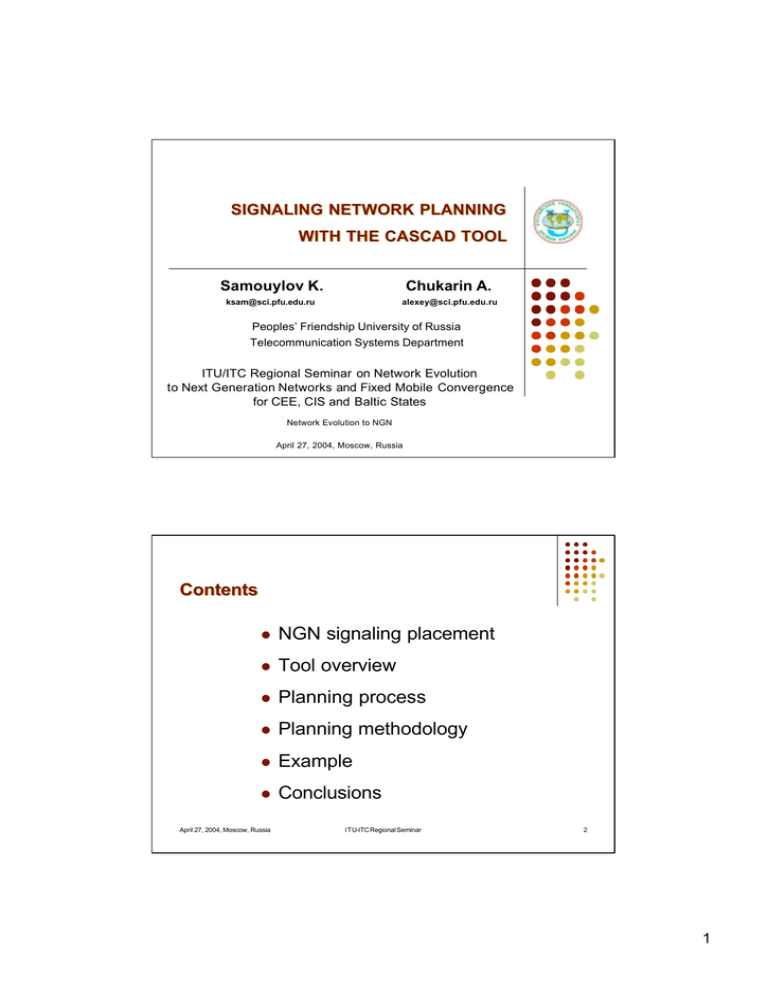SIGNALING NETWORK PLANNING WITH THE CASCAD TOOL Samouylov K. Chukarin A.
advertisement

SIGNALING NETWORK PLANNING WITH THE CASCAD TOOL Samouylov K. Chukarin A. ksam@sci.pfu.edu.ru alexey@sci.pfu.edu.ru Peoples’ Friendship University of Russia Telecommunication Systems Department ITU/ITC Regional Seminar on Network Evolution to Next Generation Networks and Fixed Mobile Convergence for CEE, CIS and Baltic States Network Evolution to NGN April 27, 2004, Moscow, Russia Contents l NGN signaling placement l Tool overview l Planning process l Planning methodology l Example l Conclusions April 27, 2004, Moscow, Russia ITU-ITC Regional Seminar 2 1 Interconnecting SS7 and NGN l Sigtran l SIP/SS7 Gateway l H323/SS7 Gateway l others April 27, 2004, Moscow, Russia (1) ITU-ITC Regional Seminar 3 Interconnecting SS7 and NGN Signaling Gateway/Sigtran NGN SS7 Network STP SS7 Interworking Function SS7 SS7 IP SSP April 27, 2004, Moscow, Russia (2) M3UA MGC M3UA AS MEGACO MG ITU-ITC Regional Seminar 4 2 Interconnecting SS7 and NGN Signaling Gateway/SIP Interworking Function (3) NGN MGC SIP SS7 IP MEGACO AS MG SS7 Network SS7 M2PA STP SCP SS7 SS7 NGN SSP MGC SIP AS MEGACO MG April 27, 2004, Moscow, Russia ITU-ITC Regional Seminar 5 SS7 Network Planning l SS7 network supports reliable transport for all cooperating networks l SS7 network planning plays significant role in future network development l Large-scale signaling network planning needs for appropriate methodology and sophisticated computing tool April 27, 2004, Moscow, Russia ITU-ITC Regional Seminar 6 3 Tool Overview Common requirements l All-purpose orientation (design, development, research) l Flexibility and Scalability (specific project task implementation) l Full modularity (interfaces to add the functions essential) System requirements l Database interconnection mechanisms (import/export data) l Optimized algorithms and programming solutions (performance) l Simplicity of use (clear interfaces, logical process) April 27, 2004, Moscow, Russia ITU-ITC Regional Seminar 7 Tool Overview Main tool features l Loading and editing of the SS7 network data l Routing plan calculation l Signaling load and signaling linkset capacities calculation l Signaling load sharing calculation l Routing table generation l Routing plan validation l Performance analysis April 27, 2004, Moscow, Russia ITU-ITC Regional Seminar 8 4 Tool Overview Example of the tool interface April 27, 2004, Moscow, Russia ITU-ITC Regional Seminar 9 Planning Process Create project Load project Create/change network topology Load network topology Load/change initial data Network topology correction Routing plan calculation Stop Stop Performance measures calculation (delays, reliability, etc) Performance analysis Routing plan validation Report generation Stop April 27, 2004, Moscow, Russia ITU-ITC Regional Seminar 10 5 Planning Process Meta process Create/change network topology Create project Load project Create/change network topology Load network topology Load/change initial data The SS7 network consists of signaling points to form the network topology. Within this topology, the routes have to be defined between the individual signaling points. When a planner creates or changes the network topology, the tool must provide the control of its correctness using the appropriate algorithms. Network topology correction Routing plan calculation Stop Stop Performance measures calculation (delays, reliability, etc) Performance analysis Routing plan validation Report generation Stop April 27, 2004, Moscow, Russia ITU-ITC Regional Seminar 11 Planning Process Meta process Routing plan calculation Create project Load project Create/change network topology Load network topology Load/change initial data This activity has been designed on the basis of the efficient numerical algorithms and therefore the process of the routing plan calculation is almost “transparent” for a planner. One should only answer a few simple questions concerning the planning restrictions in order to obtain the correct result. Network topology correction Routing plan calculation Stop Stop Performance measures calculation (delays, reliability, etc) Performance analysis Routing plan validation Report generation Stop April 27, 2004, Moscow, Russia ITU-ITC Regional Seminar 12 6 Planning Process Create project Load project Create/change network topology Load network topology Meta process Routing plan validation Load/change initial data The activity manages the key problem solution of the network planning. It includes a set of tests to verify the routing data such as the circle-free routing implementation, the availability of the signaling relations, the correctness of the SLS codes and the linkset priority allocation. Network topology correction Routing plan calculation Stop Stop Performance measures calculation (delays, reliability, etc) Performance analysis Routing plan validation Report generation Stop April 27, 2004, Moscow, Russia ITU-ITC Regional Seminar Routing Plan Calculation Process STP layering 13 STP layering DRP calculation We group the STPs into different layers taking into account their topological relationships with the SPs and other STPs. This action is necessary for the next stages of the routing plan calculation. Linkset numbering Linkset priority calculation Signaling load calculation Destination routing plan calculation Signaling link numbering DRP is defined as a set of routes destined to the concrete SP. The calculations include the route construction according to the predefined requirements. Load sharing Routing tables generation April 27, 2004, Moscow, Russia ITU-ITC Regional Seminar 14 7 Routing Plan Calculation Process Linkset priority calculation Any linkset of the network must obtain a value of the priority for message routing to every destination SP. These priorities define the normal routing as well as the alternative routing in case of network failures. STP layering DRP calculation Linkset numbering Linkset priority calculation Signaling load calculation Signaling load calculation Signaling link numbering The action provides the calculation of the load on every signaling relation between SPs and the load on every linkset of the signaling network. Load sharing Routing tables generation April 27, 2004, Moscow, Russia ITU-ITC Regional Seminar Routing Plan Calculation Process Load sharing The signaling load sharing action includes the algorithm for the SLS code calculation. The algorithm is based on the DRP multigraph edge colouring and provides the correct load sharing according to the ITU-T recommendations. 15 STP layering DRP calculation Linkset numbering Linkset priority calculation Signaling load calculation Routing tables generation Signaling link numbering The action provides calculation of the network routes and routing tables, which are constructed using the data acquired during the previous actions of the process. Load sharing Routing tables generation April 27, 2004, Moscow, Russia ITU-ITC Regional Seminar 16 8 Example of Signaling Network Graph April 27, 2004, Moscow, Russia ITU-ITC Regional Seminar 17 Example of the Routing in the Network Graph v2 v3 v5 v4 v1 v7 v6 v9 April 27, 2004, Moscow, Russia v10 v8 ITU-ITC Regional Seminar 18 9 Notation G = (V , E) v2 Network graph v3 v5 V =V 1∪V 2 Vertex set of the graph G v4 v1 v7 v6 v10 L(u,v) = t v9 Number of the inner vertices of the path v8 l(u,v) = (u, x 1 , …, x t , v) path April 27, 2004, Moscow, Russia ITU-ITC Regional Seminar 19 Restrictions for the Set of Paths v2 v3 v5 v4 v1 v7 v6 v9 April 27, 2004, Moscow, Russia v10 v8 ITU-ITC Regional Seminar 20 10 Restrictions for the Set of Paths (i) The number of the inner vertices of a path must not exceed the given value, i.e. 0 = L(u,v) = T (ii) A path must be a simple chain in the graph G, and its inner vertices (if they are exist) should belong to the set April 27, 2004, Moscow, Russia V2 ITU-ITC Regional Seminar 21 Variants of the Vertex Set Decomposition April 27, 2004, Moscow, Russia ITU-ITC Regional Seminar 22 11 Criteria 1 of the STP Network Decomposition The number of bi-components should be minimal. April 27, 2004, Moscow, Russia ITU-ITC Regional Seminar 23 Criteria 2 of the STP Network Decomposition The number of vertices in the largest bi-component should be maximal from the all decompositions. April 27, 2004, Moscow, Russia ITU-ITC Regional Seminar 24 12 Variants of the Vertex Set Decomposition April 27, 2004, Moscow, Russia ITU-ITC Regional Seminar 25 Example of the criteria application v2 v3 v5 v4 v1 v7 v6 v9 April 27, 2004, Moscow, Russia v10 v8 ITU-ITC Regional Seminar 26 13 Example of the Destination Routing Plan April 27, 2004, Moscow, Russia ITU-ITC Regional Seminar 27 Example of the Routing Tables April 27, 2004, Moscow, Russia ITU-ITC Regional Seminar 28 14 Practical Results Russian SS7 Toll Network (Rostelecom, national level) l 16 STPs divided in 2 layers, ~ 150 SPs l ~ 25000 signaling routes SS7 Network of the Moscow Region (CentreTelecom, local level) l 6 STPs, ~ 100 SPs l ~ 10000 signaling routes April 27, 2004, Moscow, Russia ITU-ITC Regional Seminar 29 Conclusions Results l Methodology for the network planning at the MTP3 level l Application of the tool and the methodology for the Russian large-scale signaling networks planning Future work l Auxiliary planning aspects of NGN l Algorithms for the SS7 network performance analysis April 27, 2004, Moscow, Russia ITU-ITC Regional Seminar 30 15



